11300 A RARE PAIR OF MAHOGANY CENTER TABLES IN THE LATE REGENCY TASTE WITH ORIGINAL SPECIMEN INLAID FIGURAL INSET MARBLE TOPS ALMOST CERTAINLY BY J. DARMANIN & SONS OF MALTA The Tables English or American. The Tops Maltese. Both Second Quarter Of The Nineteenth Century. Measurements on Request.

Research
Each of mahogany. The circular tops with D-mold edge and plain frieze have a crossbanded border enclosing inset inlaid marble tops, one centered by a spread-winged parrot resting upon a single branch. The outer portoro marble band enclosing two rings of specimen marbles, one band with repeating ovals and lozenge shapes. The second marble top identically composed except the central roundel is set with a figure of a warrior holding a staff with the word Karthago engraved below. Each base with circular molded tapering stem held within a carved cup-shaped motif which in turn rests on gadrooned collars; evidence of past slight reduction in height at the very top of the stem; this has now been corrected. The plain tripartite incurved plinth raised upon three carved leonine feet.
The fine specimen inlaid marble tops of the present pair of tables were almost certainly executed by the firm Joseph Darmanin & Sons (translated from ‘Giuseppe Darmanin e Figli’) of Malta.
The important recent discovery of a Darmanin label on a circular center table in the Victoria & Albert Museum (figure 1) has led to the attribution of a number of table tops with shared characteristics. Made circa 1841 the top is decorated with a central roundel of the well-known ancient Roman motif “Pliny’s Doves,” surrounded with seashells and coral. The top rests on a mahogany pedestal and tripod plinth with gadrooned carving, similar to the present piece.
The Darmanin firm was first established by Giuseppe (1779-1863) on the Strada Levante, Valletta, and the Darmanin family became the leading 19th century marble workers of Malta. The location of the workshop near the harbor was ideal for the importation of marbles from abroad, as well as the arrival of foreign visitors.
By the second quarter of the 19th century Giuseppe was joined by his sons Salvatore, Michele, Giovanni, Paolo and Carlo; the family continued to trade as ‘Giuseppe Darmanin e Figli’ into the 1880s. A majority of the Darmanin’s Maltese projects were architectural in nature, altars, tombs, and paving work for churches, as well as extensive marble work at the Governor’s Palace. Their production of mosaic marble tabletops began in the 1830s and catered to wealthy British clientele who would acquire Italian works in marble as mementos of their Grand Tour. So superior was the quality of their production that when further work was needed for armorial tablets, the then-governor of Malta, Sir Arthur Borton stated that “Messrs Darmanin should have the work, as they are acknowledged to be the best workers in marble in the island, and the coat of arms to be properly cut is in itself a work of art. It might probably be done cheaper by tender by some other workmen, but the quality of the work would be inferior.”1
In 1840, Giuseppe Darmanin’s nephew, Salvatore Cumbo, recorded an eye-witness account of the workshop in Strada Levante, “describing the range of tabletops in progress ‘…The tables were in different styles but all done with equal perfection. One was inlaid with a garland of roses, another with a circle of shells; another shows a Carthaginian horse, another a warrior, another a family coat of arms’.”2
The present tops each follow the same overall decorative scheme in specimen marble comprising concentric rings inlaid with alternating oval and lozenge shapes, centered by a figural vignette. One tabletop depicts a parrot with outstretched wings perched on a single branch on a white ground. The second top is set with a warrior holding a staff against a black ground with the word Karthago (Carthage) below. Emblems of ancient Carthage were known to have been used by Darmanin & Sons in reference to Malta’s ancient past as a colony of Carthage, part of the Phoenician Empire.3 The stones have been carefully chosen for their color gradation which naturally gives the impression of shading.
It is the Carthaginian warrior motif which allows the present tops to be attributed to J. Darmanin & Sons, as this relates to a top illustrated in Edward Joy’s English Furniture 1800-1851 (1977, p. 284), a table illustrated in Kate Hay’s “Mosaic Marble Tables by J. Darmanin & Sons of Malta” (Furniture History, 2010, p. 179), and a tabletop formerly in the British Art Trade that bears a partial label for the firm (figure 2).
Another area of the Darmanin’s work was devoted to armorials, table tops with intricately inlaid family crests and coats of arms. Notable examples include a pair of tables made for Charles William Vane, 3rd Marquess of Londonderry, as well as tops bearing the arms of the Bebb family of Donnington Grove, Robert King, 1st Viscount Lorton, the Baker family of Lismacue, Tipperary, Ireland, and table with a top emblazoned with the arms of John Howard Galton Esq. of Hadzor Hall (formerly in the Carlton Hobbs collection and now at Lotherton Hall, Leeds). A further closely related table of American origin, made by A-G. Quervelle, Philadelphia, circa 1830, with a Darmanin top of geometric design is also illustrated in English Furniture, p. 253.4
Among the Darmanin’s most impressive patrons were the British royal family. Salvatore Cuomo’s account of the workshops also mentions a tabletop for Queen Adelaide which stood out “as the moon stands out among all the stars.” Though the current whereabouts of the table is unknown, it noted that the top contained two coats of arms, one of the Royal Family of Clarence and the other unidentified. Three other tabletops by the workshop are in the Royal Collection and bear the royal arms of Great Britain. One of these also incorporates Maltese emblems, and was displayed at the Great Exhibition of 1851 where the Darmanins were awarded a prize medal. The family showed their work at several other international exhibitions in including the 1862 London exhibition, 1867 Paris exhibition, and 1886 Colonial and Indian Exhibition in London.
Not only are the present tables notable for their splendid marble tops, but it is rare to find such examples in pairs, especially mounted on finely carved bases.
Footnotes:
1. Hay, Kate. “Mosaic Marble Tables by J. Darmanin & Sons of Malta.” Furniture History, 2010, p. 165.
2. Ibid., 166.
3. Ibid.
4. Joy, Edward T. English Furniture 1800-1851, 1997, p. 253.

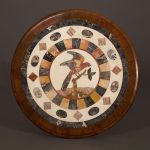
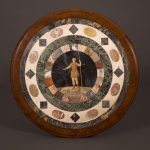

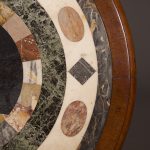
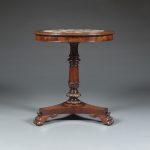
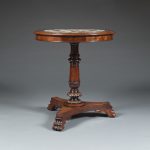
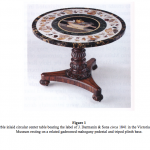
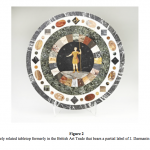
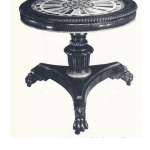
Comments are closed.